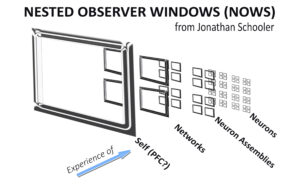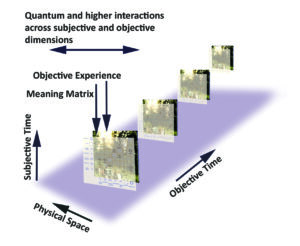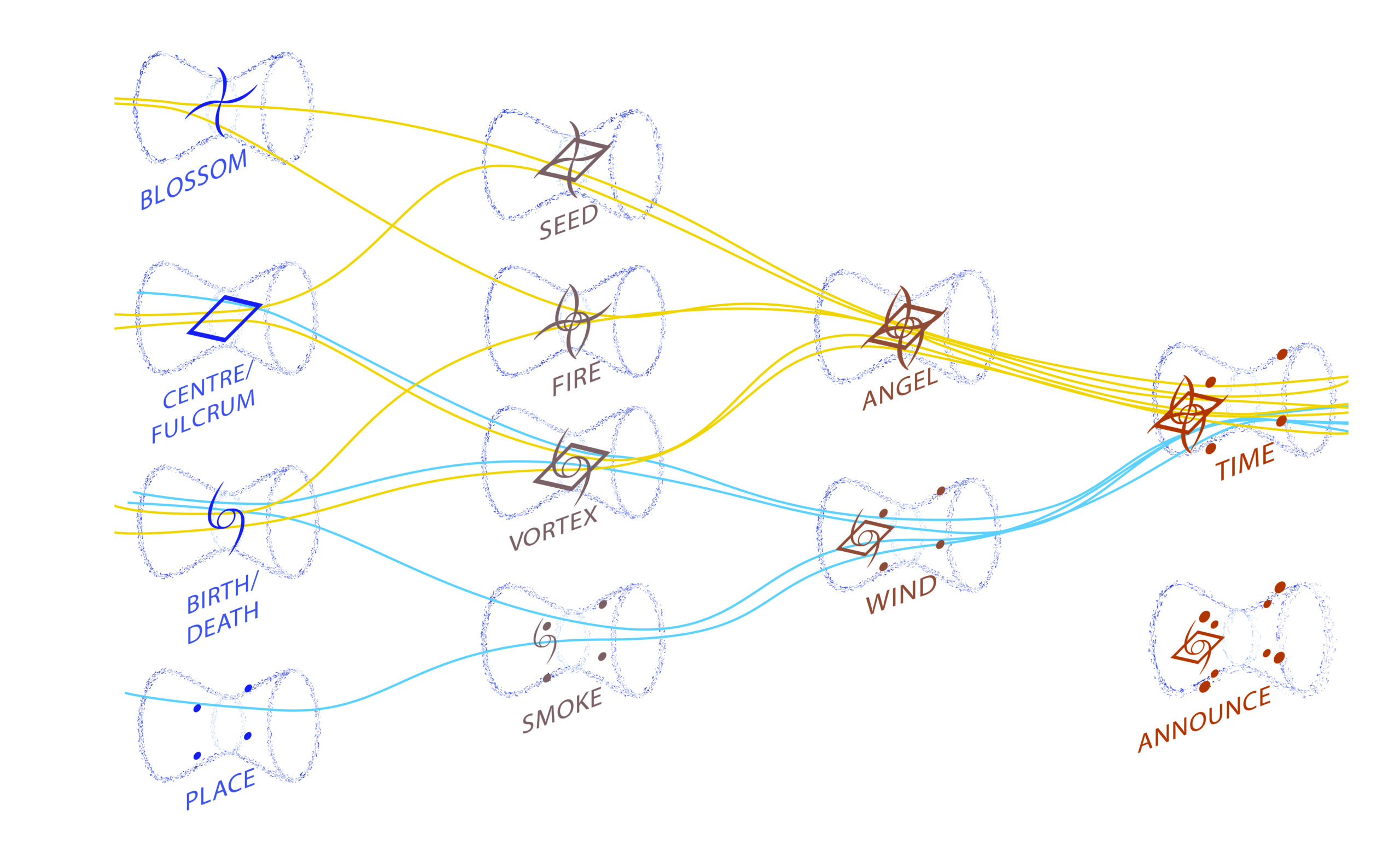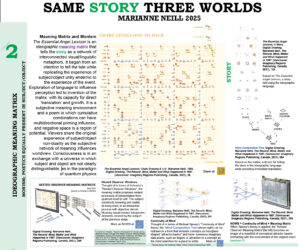The image provides a reference to Section 2 of the poster One Story Three Worlds, for the Science of Consciousness Conference, Barcelona, 2025. This post contains further information about research referenced in this section.
View The Essential Angel Lexicon meaning matrix
Schooler’s Nested Observer Windows & Spivey’s Continuity of Mind
Sections are
1. Schooler’s Nested Observer Windows
2. Spivey’s Continuity of Mind Theory
3. Links to Relevant Research
Schooler’s Nested Observer Windows
Multiple Consciousnesses
NOWS Theory: The subject involves multiple consciousnesses moving at different temporal rates (evidence in Healy et al., 2013) as a series of Nested Observer Windows (see image below). This means areas of the brain that integrate less information move faster relative to objective time. As this occurs, advanced levels hold information for later levels that compile more information and move more slowly through objective time. As suggested in the diagram below, each level includes all the information from the levels beneath it.
While the subject moves through time, s/he detects physical holons with every level engaged in its own way. (A holon is information in the universe involving self-similarity across a range of scales, as in a hologram (term originated with Koestler, 1967 The Ghost in the Machine.))
 Digital Drawing; Marianne Neill, The Record: Mind, Matter and What Happened in 1987. (Vancouver: Imaginary Regions Publishing, Canada, 2021), 264
Digital Drawing; Marianne Neill, The Record: Mind, Matter and What Happened in 1987. (Vancouver: Imaginary Regions Publishing, Canada, 2021), 264
Based on Jonathan W. Schooler, “Towards a Framework for Conceptualizing Observers Moving Through Time: Nested Observer Windows/Waves” (presentation, Science of Consciousness Conference, San Diego, CA, June 5-10, 2017) or “Plenary 11 Vibrations, Resonance and Consciousness”, YouTube video, 36:45.
Subjective Time
In conclusion, Schooler proposes a fifth dimension of subjective time, moving perpendicular to objective time, with the subject moving on an upward diagonal through both objective and subjective time simultaneously. To illustrate this idea, in the graphic below, physical space is compressed into a flat area, with subjective time moving up the vertical axis as a fifth dimension.
The image of the meaning matrix in the graphic represents the subject in interaction with the objective world, represented behind it. The idea of NOWS and corresponding nested meaning matrices is implicit in the bi-directional arrow for quantum and higher (space-time) interactions across subjective and objective dimensions.
For more information about the meaning matrix, click on the image of the poster above.
 Digital Drawing; Marianne Neill, The Record: Mind, Matter and What Happened in 1987. (Vancouver: Imaginary
Digital Drawing; Marianne Neill, The Record: Mind, Matter and What Happened in 1987. (Vancouver: Imaginary
Regions Publishing, Canada, 2021), 266
Based on Jonathan W. Schooler, “Towards a Framework for Conceptualizing Observers Moving Through Time: Nested Observer Windows/Waves” (presentation, Science of Consciousness Conference, San Diego, CA, June 5-10, 2017) or “Plenary 11 Vibrations, Resonance and Consciousness”, YouTube video, 36:45.
Spivey’s Continuity of Mind Theory
Interconnection of Mind and Environment
Michael Spivey’s Continuity of Mind theory presents evidence that mind and environment are dynamically interconnected. As such, evolutionary, cultural, social, and parental influences cannot be separated from what the mind is. So humanity is a cognitive system in which individual minds are overlapping dynamic informational sub-processes.
Individual Cognition
For the individual consciousness, mind exists as a trajectory through probabilistic states, operating simultaneously at every level of mental processing. This means that cognitive processes involve interaction of neural subsystems, continuously interacting and even sharing partial information while processing. There are regions in mental state space, in every subsystem, called “attractor basins” that correspond to mental states. At different levels, they could correspond to percepts, categories, words, actions, sentences, or goals. In a dynamic state of moving between these attractor basins, the mind settles on the most likely percept, concept, or category, and moves on. Movement to the next state, or event, is influenced by, or “primes” the next.
Concept-Formation
So, Spivey’s theory of concept-formation is that ideas arise as the mind’s trajectory flows between sense perception and action in a system that involves brain, body, and environment, and all potential trajectories to and from a concept define what that concept is. Spivey compares the range of potential definitions to the light cone in physics, so potential contents of a concept are shown as an hourglass-shaped manifold.
Reinterpretation of the Meaning Matrix
When reinterpreted as such a manifold, the ideograms of the meaning matrix become events in which mental trajectories “settle” on a concept corresponding to a stimulus. In addition, the process of concept-formation is in an interaction with all dynamic subsystems, from quantum to self, so there would be imaginary nesting of information from neural subsystems, as well as nesting of lower within higher dimensional concepts.
This interpretation of art in terms of science brings new content to drawing. The dynamic interpretation contains new imaginary information about degrees of attraction from one basin to the next, and the number of times the mind tracks through a certain concept in the meaning environment. As well, the dynamic drawing appears to include the element of time and dynamic change, unlike the more static tree structure of the original artwork (see image below and poster thumbnail above).

Digital Drawing; Marianne Neill, The Record: Mind, Matter and What Happened in 1987. (Vancouver: Imaginary Regions Publishing, Canada, 2021), 291.
Conceptual attractor basins as light cones based on Michael Spivey’s The Continuity of Mind
Links To Relevant Research
Michael Spivey, The Continuity of Mind (Oxford: Oxford University Press, 2007).

